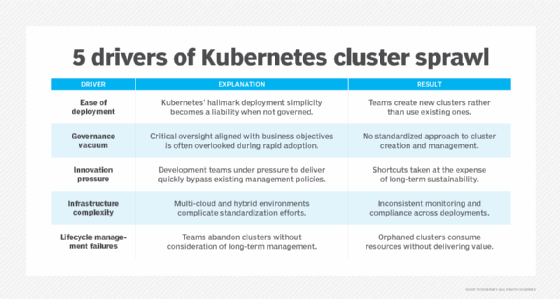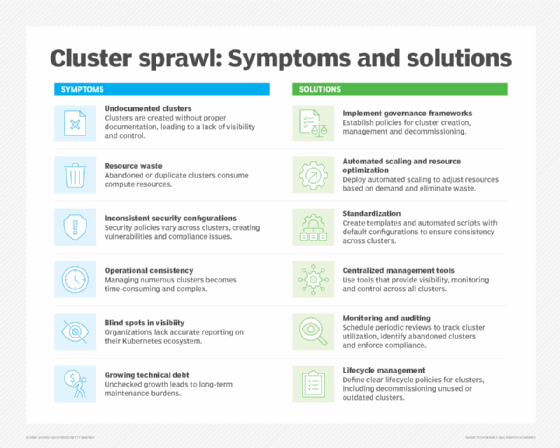
Getty Images/iStockphoto
The cost of Kubernetes cluster sprawl and how to manage it
Kubernetes cluster sprawl undermines efficiency and security. Implement governance, standardization and monitoring to balance developer freedom with operational control.
As Kubernetes adoption accelerates across industries, organizations face a growing challenge: cluster sprawl. The uncontrolled proliferation of Kubernetes clusters threatens to undermine the very benefits that make the open source platform appealing.
The Kubernetes advantage and sprawl challenge
Kubernetes has become the industry standard for orchestrating containerized environments, offering automated deployment, management and scaling across clusters. It provides critical capabilities, such as container self-healing, intelligent load balancing and secure configuration management, while maintaining the portability and flexibility required by sophisticated applications. At its core, Kubernetes operates with a two-tiered architecture: The control plane handles configuration and scheduling, while worker nodes supply the compute resources necessary to run containerized applications.
However, Kubernetes' greatest strength -- deployment simplicity -- can become its weakness. The ease of creating clusters often leads to cluster sprawl when left unchecked. Kubernetes cluster sprawl typically occurs when teams adopt a "try it and see" approach, spinning up numerous clusters for various projects or initiatives without proper documentation or oversight.
As a result, organizations face a growing number of poorly managed, resource-intensive clusters that are difficult to monitor, secure and optimize.
What drives Kubernetes cluster sprawl?
Several factors contribute to unmanageable Kubernetes growth:
- Ease of deployment. Kubernetes' hallmark deployment simplicity becomes a liability when not governed.
- Governance vacuum. Like any critical IT service, Kubernetes requires consistent oversight aligned with business objectives. This requirement is often overlooked during rapid adoption phases.
- Innovation pressure. Development and deployment teams are under immense pressure to innovate and deliver quickly, possibly causing them to bypass existing cluster management policies perceived as roadblocks.
- Infrastructure complexity. Multi-cloud and hybrid environments significantly complicate standardization, monitoring and compliance efforts across Kubernetes deployments.
- Lifecycle management failures. The perception of unlimited compute power, especially in cloud environments, encourages teams to deploy and subsequently abandon clusters without consideration of long-term management.
Organizations must carefully examine how these factors interact within their specific environment, particularly considering how today's emphasis on development agility affects infrastructure governance.

Business impact
The consequences of Kubernetes cluster sprawl extend beyond technical inconvenience:
- Operational inefficiency. Management becomes increasingly complex and time-consuming as clusters multiply without standardization.
- Growing technical debt. Today's ungoverned growth translates into tomorrow's maintenance burden, with costs compounding over time.
- Security vulnerabilities. Inconsistent security configurations across clusters create exploitable gaps and compliance issues.
- Resource waste. Abandoned and duplicate clusters consume computing resources without delivering business value.
Perhaps most concerning is the loss of enterprise visibility. Organizations struggling with cluster sprawl often lack accurate reporting on their Kubernetes ecosystem, leaving them with blind spots containing unknown workloads and unmanaged resources.

Strategies to control Kubernetes cluster sprawl
Organizations can manage Kubernetes proliferation through structured governance. This approach standardizes environments, establishes deployment approval processes and enforces security baselines and compliance requirements. Additionally, it schedules regular reviews to eliminate abandoned deployments. Model your Kubernetes governance after existing management frameworks that support other critical infrastructure investments, such as cloud or database systems.
A comprehensive governance strategy should address several key areas:
Standardization
Implement standardization by defining clear configurations, including templates and automated scripts with default settings.
Monitoring and auditing
Establish monitoring and auditing guidelines to track utilization, growth and scaling.
Centralized management tools
For large-scale Kubernetes environments, deploy centralized management tools that enable delegation, monitoring and visibility across all clusters. Ensure the management tools support both on-premises and cloud-based deployments.
Automated scaling
Implement automated scaling that expands to meet demand and reduces resources when demand decreases.
Balancing control and innovation
The goal is to balance developer autonomy with standardized management. Measure success by how well you centralize oversight while preserving developer freedom to innovate. Aim to maintain efficiency without becoming a roadblock to experimentation and progress.
Take control of your Kubernetes environment
The proliferation of Kubernetes-hosted applications shows no signs of slowing. Early intervention prevents minor issues from evolving into major headaches. Implementing these techniques helps maintain control and efficiency as your container environment expands.
Damon Garn owns Cogspinner Coaction and provides freelance IT writing and editing services. He has written multiple CompTIA study guides, including the Linux+, Cloud Essentials+ and Server+ guides, and contributes extensively to Informa TechTarget, The New Stack and CompTIA Blogs.







